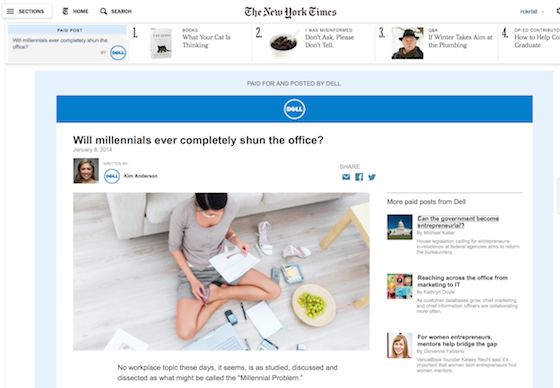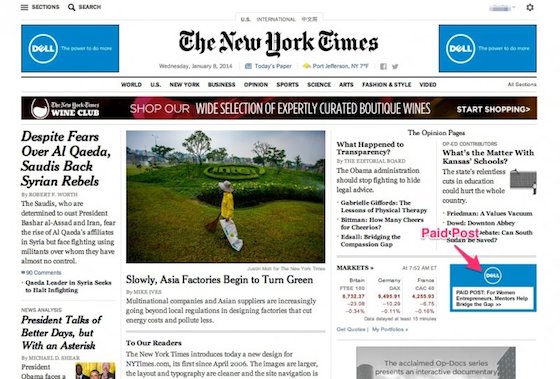The New York Times is now in the native-advertising game, and that’s raised the hackles of folks like Andrew Sullivan, Michael Wolff, and Tom Foremski.
But native ads aren’t inherently worse than regular ads. It’s all about the disclosure, and the Times has done that well here.
All ads are potentially problematic for journalism. The conflicts of interest are built in. Shall we cover this General Motors story, say, and lose our biggest advertiser (as The Wall Street Journal courageously did in the 1950s) or ignore it or at least soft-pedal it a bit? Shall we put our Homes reporters on this predatory-lending story or have them continue writing about quirky radiators and toilet-flushing confusion? Shall we bundle this lucrative newspaper insert put together by the Chinese government and made to look like a real paper?
Trade-offs, you know.
The particular problem with native advertising is its potential to trick readers into thinking it’s not advertorial. It’s an existential one, actually, as Audit Chief Dean Starkman wrote a year ago: Make the ad too native and it’s deceptive. Make it too ad-like and nobody will want to read it.
The Times‘ Dell ad, its first, is firmly in the latter. Here’s what it looks like on my screen:
It’s hard to imagine anyone mistaking this page for an actual New York Times story (perhaps not least because Times copy editors would have whacked a couple of these ledes).
First, the Times didn’t place the story in the news area on its homepage. It put it in an ad spot and put “PAID POST” in all caps. The NYT isn’t serving the ad in Denmark, where I am, so here’s Business Insider’s screen capture:
Now, readers can come in via links, obviously. But the giant blue border with Dell’s logo and “PAID FOR AND POSTED BY DELL” around the actual posts is plenty of signal that this is not a Times story, as is the byline, which has the Dell before the writer’s name, even.
The font is different and smaller, and the actual NYT stories linked to are clearly labeled “SELECTED BY (Dell logo).
Critically, the Times isn’t even letting search indexes spider these URLs. You can’t find them in Google results even if you search for quotes or the URL. That means these ads won’t get intermingled with NYT results in search results.
So when Andrew Sullivan says this, he’s arbitrarily demanding higher standards from digital—where the ads bring about a tenth of the cash—than from print:
When we picked a pure subscription model over a year ago, I honestly wouldn’t have believed that a year later, even the NYT was knee-deep in corporate propaganda with the NYT logo and other articles at the top of the page. Especially after their great pay-meter success, why sacrifice something so special as the integrity of the NYT for what cannot yet be big bucks?
Look, I’m no fan of native advertising, but truth be told, I don’t like advertising, period. It will always coexist uneasily with journalism because journalism is (or should be) about getting at the truth as best we can, while marketing is inherently about manipulating people to get us to buy stuff.
Ads are a necessary evil, alas. And these NYT ads are no worse than the “special advertising sections” that magazines and papers, including the Times, have run for decades. I’d say these ads are better-demarcated than many of those sections, actually.
Native ads aren’t inherently worse than regular ads. It’s all about the disclosure, and the Times has done that well here.
The potential problems are down the road, and we and others will be watching closely. If nobody reads them, will the Times make the disclaimers less obvious?
Let’s hope not. Until and unless that happens, then, these are fine.
Ryan Chittum is a former Wall Street Journal reporter, and deputy editor of The Audit, CJR’s business section. If you see notable business journalism, give him a heads-up at rc2538@columbia.edu. Follow him on Twitter at @ryanchittum.


